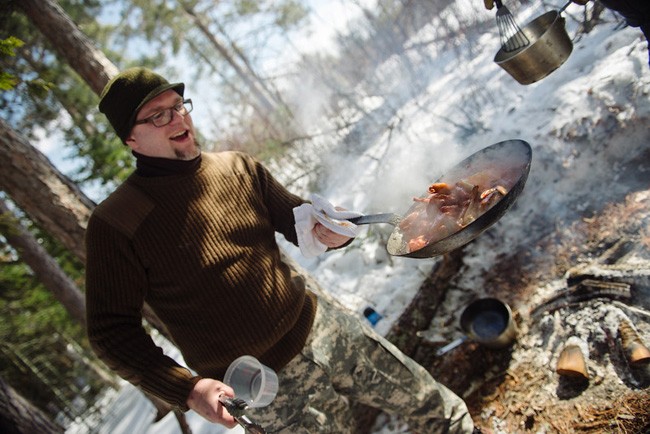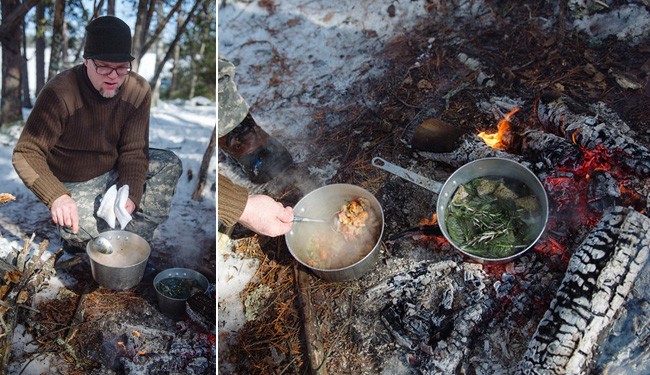
This story was sponsored by the Campaign to Save the Boundary Waters. It’s the first of a five-part series that will run on Heavy Table telling the story of Ely, its economy, and a special wilderness meal created by Chef J.D. Fratzke of The Strip Club Meat and Fish.
Our March 1 trek over the frozen surface of a northwoods lake started as a winter daydream. The idea was to cook and eat a multi-course meal, profoundly Minnesotan, referencing the lakes, the streams, and the woods, cooked over a campfire in the Boundary Waters in winter. Think snow and fire; ice and coals; wild rice and duck.
Unexpectedly, things fell into place. The Campaign to Save the Boundary Waters backed the plan. Chef J.D. Fratzke of The Strip Club Meat and Fish rallied behind the idea and packed the food, pans, and knives. And before we knew it, we were driving north from Minneapolis to the wilderness gateway of Ely, our car laden with flatware, linens, cups, camp plates, thermoses, flasks, and a five-foot long piece of gnarled beechwood from Wood From the Hood that would serve as our tabletop.

Our destination was an island campsite on Fall Lake, via Entry Point 24. We were dressed in many layers. We were, we figured, ready for the cold. We were ready to eat. And we were ready to get back out into the Boundary Waters, despite the weather.
If you’ve ever spent time in Minnesota’s wilderness, whatever the season, you know that it’s a place defined by space – the space between islands and the shore, the space between the water and the sky, and the space between sounds, which can be few and far between. As you take in the space, you start to hear things that would otherwise be lost: the crunch of ice under your snowshoes, the rushing babble of the wind moving through the trees, the susurration of your own breath.
Eventually, you become aware of the thoughts that inhabit your own mind, exposed after months (or years) of being entombed within layer after layer of email, tweets, junk mail, radio transmissions, text messages, and human conversation.
We figured that the combination of unjacketed thoughts and great food would result in some spiritual alchemy. And we wanted to bring the flavors of a local feast to the cold, crisply elegant silence of the northwoods wilderness.
We also wanted to see how much better a chef-made bloody mary would taste after a hike across a frozen lake.

TREKKING OUT AND SETTING UP
Our group arrived in three parts. First on the scene at the Fall Lake campsite were our guides and outfitters, Steve Piragis (of Piragis Northwoods Company) and Steve Johnson. Their efforts meant that when we arrived at the site, we were greeted by a lively campfire (with coals for cooking in), and a miraculously warm woodstove tent. Stoked consistently, the tent – which easily packed down to a sled-conveyable size – stayed at a comfortable 50-70 degrees, wind and snow notwithstanding.
The Heavy Table group arrived next: myself (James Norton), photographer Becca Dilley, Chef Fratzke. I hauled our pulk the first half of the distance to the site; Fratzke took it the rest of the way. The snow on the frozen lake was shallow enough near the shore, but it began to swell as we moved to the north. Suddenly, the snoeshoes made sense – they were the difference between a painstaking punch-through-the-snow / extract-the-leg march and a relatively simple pilgrimage across the snow’s surface.

The sled was heavy, but still a minor miracle of ancient mechanics – a load that would have been staggeringly tiresome slung across our backs became eminently manageable by one person, the sled serving as the cold-weather equivalent of the load-bearing canoe that is the BWCA’s summertime beast of burden.
The final guests to join the group were explorers Dave and Amy Freeman. The Freemans’ canoe trek from Ely through Canada to Washington D.C. helped to get people talking about the sulfide ore-mining threat to the Boundary Waters, but today they were just returning from a ski trip with big appetites, and we happened to be cooking brunch.

FIRST TASTES
The first thing to hit our lips was coffee from Ely’s Front Porch Coffee and Tea Co. The barista had steamed the interior of our Coleman Thermos before filling it with the equivalent of two and a half large cups of coffee; that thoughtfulness meant that even after our cold-weather trek, the liquid was piping hot.

The second thing we tasted was a bloody mary whose constituent elements had been selected, packed, and sledded out to the campsite by Fratzke. Crowned with celery and a savory grass-fed beef stick, it was bright, it was profoundly inhabited by the pulverized soul of tomato, and it was boozy without tasting like it. Sucked out of metal camping cups held in gloved hands, it was a welcome and reviving shock to our chilled systems.
By the time I turned my attention back to my little cup of coffee, the bulk of it had frozen solid, leaving a few tablespoons of chilled liquid cradling a coffee ice cube. Only ten minutes had gone by, but the wind was blowing at a decent clip and the temperatures were comfortably below freezing.

These conditions meant that the next dish Fratzke prepared was not merely good, but was in fact agonizingly transcendent. Working with the coals of the campfire, he sauteed a massive mess of quail legs, joyfully tossing them a good foot from the pan in a tumbling mass of poultry before catching them all.

He then covered them in butter and a custom-crafted hot sauce made from three kinds of pepper. The result were tiny little Buffalo wings served with Caves of Faribault blue cheese. They were tender to the point of ridiculousness and flavorful to the point of fiction.
We mowed them down.

THE MAIN COURSE
The day’s main fare was as hearty as we could’ve hoped for. Fratzke cooked big, gorgeous tenderloins of venison over the campfire in a red wine reduction, big tendrils of yellow flame licking their way out of the pan. He served these with a butter bean and duck confit dish that conjured up cassoulet, a salad of braised greens with bacon and crayfish, and a remarkable “trencher” comprised of polenta, wild rice, and buffalo-cranberry pemmican.

The venison was tender and rich, supported by the earthy, complex flavors of the trencher and elevated by the crayfish and greens. As we tucked happily into the substantial heart of our meal, Fratzke told us about why he set our table with cedar branches in addition to our food and drink.

“The first time I came up here in the winter was a dogsled trip, and I met this Finnish guy named Erik [Simula] who took me out with his team one day,” Fratzke said. “He had been married to an Ojibwe woman who lived a traditional lifestyle. We stopped and we let his dogs rest and we did a little work on the trail. I told him what a great time I was having and how grateful I was that he’d brought me out on the trail, and he said: ‘Let’s walk to the lake and we’ll make an offering. A lot of times natives will make an offering of tobacco, but I don’t smoke, so I don’t carry tobacco. And before tobacco came around, it was traditional to leave an offering of cedar branches, because the cedar is sacred to the Ojibwe.’ So we laid some on the lake and gave thanks.”
For Fratzke, the meal we’d enjoyed was about creating a historical throughline, a straight path from modern travelers in a pristine wilderness back through the voyageurs back through to the American Indians who walked these shores and paddled these lakes. The spruce tip tea we sipped had a subtle flavor like nothing most of us had tasted before, and it was a potable connection to the trees that surrounded our campsite.

“I wanted the meal to consist of things that have been available here for thousands of years,” said Fratzke. “I wanted us to taste deep Minnesota history — I wanted us to taste Boundary Waters history. The wild is predominant … the voyageurs with the rubaboo that I did in the polenta style … ducks, obviously. Venison, obviously — wild greens. About the only thing that’s not ancient Minnesota is the pork, and that’s still pretty Minnesota.”

CHOCOLATE AND SNOW AND THE TRIP BACK HOME
Fratzke’s dessert was basic but brilliant as only simple things can be. It consisted of profoundly dense, almost flourless brownies wrapped in foil and warmed in the embers of the fire, topped with alcohol-macerated griotte cherries and a dusting of powdered sugar.

Our guides and the wilderness-savvy Freemans managed to pack up camp quickly; even the woodstove tent came down and was stowed for transport in a matter of minutes. The stove cooled to a safe temperature quite rapidly with the help of the frigid March air. As we trekked out of the Boundary Waters to return to Ely, we were aware that this day would stick with us for a while.

A Boundary Waters Winter Feast
Prepared by Chef J.D. Fratzke on Fall Lake
March 1, 2015
Opening Salvo
Bloody Mary with Celery Stalk and Bison Stick
Canapes
Smoked Walleye Mousse and Chives
Bison Braunschweiger
Rye Crackers

Appetizer
“Buffalo” Quail with Caves of Faribault St. Pete’s Select Blue Cheese

Brunch Plate
Venison Tenderloin with Minnesota Wild Rice and Pemmican “Trencher” and Duck Egg
Braised Greens with Bacon and Crayfish
Stewed Butter Beans with Duck Confit and Maple Syrup

Dessert
Fire-Warmed Chocolate Brownie with Griotte Cherries and Powdered Sugar
Drinks
Bloody Marys
Spruce Tip Tea with Chamomile


